Your Guide to Getting Your Sleep

Here at Daniels Chiropractic in Caledonia, Mt. Pleasant, and Racine, Wisconsin, sleep is one of the most common and important topics we discuss with our patients. A good night's sleep should recharge your batteries, decrease pain, and get you ready to start the next day refreshed.
However, if you are not getting good quality sleep, you will feel tired, irritable, and in more pain than when you went to bed. Patients often blame their poor-quality sleep on an old mattress. Yet, sleeping in the wrong position can also cause pain and limit quality sleep. So, before you invest in a brand new mattress, be sure you are sleeping in the proper position for you.
Each position comes with pros and cons. You and your chiropractor can discuss which position will work best for you. At the end we also share some helpful tips for creating a good sleep environment.
First, let’s look at side sleeping.

Side Sleeping
Sleeping in a side-lying position is the most common sleep position. It’s an excellent option for most people when done correctly.
Some of those who benefit from side sleeping are those suffering from low back pain, sciatica, and sleep apnea.
Interestingly, research suggests that sleeping on your left side is preferable to your right. Thanks to the unique arrangement of your internal organs, left-side sleepers may see benefits in improved digestion and blood flow.
An added benefit of side sleeping is that it can also help reduce heartburn.
Side Sleeping Cons
There are a few things that can go wrong when side sleeping:
Numbness
When your arm is under your side you may wake with numbness in the arm and hand.
Shoulder pain
Sleeping on one’s side may put too much pressure on the rotator cuff and cause pain or injury.
Hip pain and/or low back pain
This kind of pain is a result of poor positioning while side sleeping and it can be corrected. See the tips for proper positioning below.
Neck pain
Again, you may have neck pain after side sleeping NOT because of sleeping on the side but because of improper positioning due to poor pillow support. This is easily corrected with the proper pillow height and firmness for your build.
How to Side Sleep Properly
Follow the tips below to be sure that you benefit from side sleeping and don’t fall into a poor sleeping position.
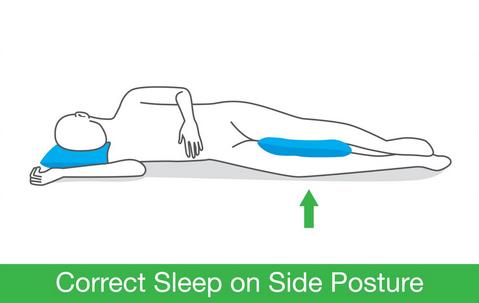
Keep your back straight
Sometimes we tend to curl up to “get comfortable” and warm in bed. But if you fall asleep like this your spine is not in “neutral” position - the best position for it to rest and experience the least amount of stress.
As you get comfortable at night, be sure you are not twisted or curled into a C position. Lengthen your torso and “straighten” out. Your legs can be bent, but your back should not be curved into a fetal position.
Bend your knees slightly
This releases the tension in muscles that may pull on your lower back.
Position a pillow between your legs
This also reduces the pressure on the low back and hips.
Select a pillow with proper support for your neck
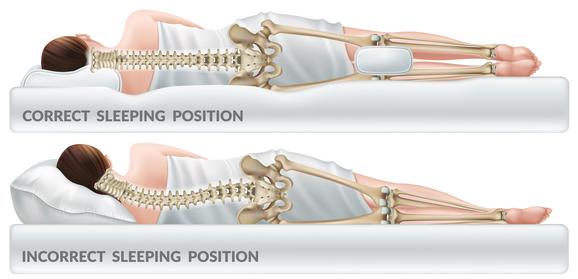
You want your neck to be in alignment with your spine - not lifted up too high and not dropping down. A tall, firm pillow that keeps your neck straight is better for your spine. A too-soft pillow will allow your neck to drop and be cocked to one side all night. No wonder we wake with neck pain after sleeping all night on a fluffy pillow with very little support!
The reality is that when we’re younger our body can often “bounce back” from this kind of stress on our neck. As we get older we can’t afford to sleep in an improper position all night. We pay the price the next day (or week!).
Position yourself correctly to avoid shoulder pain
The first key to fighting shoulder pain is also to have a pillow for your neck at the correct height.
After you choose a good pillow for your head and neck, pay attention to your arm position to avoid shoulder pain. If your shoulder is already hurting, then sleep on the opposite shoulder from the pain and position a small pillow for your upper arm to rest on in front of your chest. This will reduce the strain on your aching shoulder as you sleep.
If your shoulder continues to hurt please give us a call at 262-638-9999 and we can help you begin to feel, move, and live better.
Invest in a good mattress
A quality mattress that supports the curvature of your body, while still embracing the pressure points of your shoulders and hips, is very important.
Does your mattress sag or have a noticeable dip where you sleep? Or have you used your mattress for more than 10 years? It may be time to shop for a supportive, firm-enough-for-you mattress.
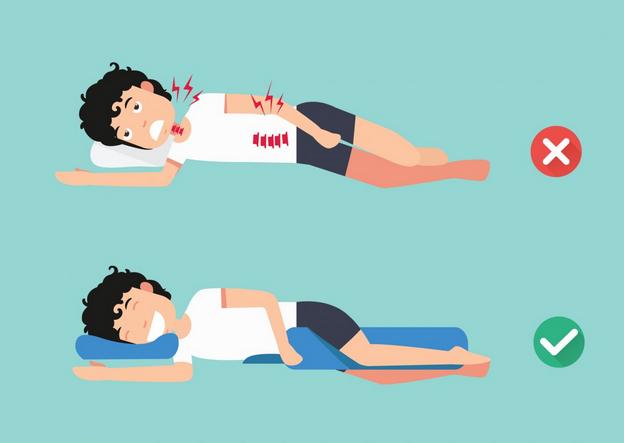
Back Sleeping
Sleeping on your back is sometimes recommended as the best position for preventing aches and pains in the morning.
It’s true that lying on your back evenly distributes weight across the broadest surface of your body, minimizing pressure points and ensuring proper alignment of your spine and internal organs. Back sleeping may be the best position for those suffering from shoulder pain, rotator cuff tendonitis, and neck pain. Back sleeping can also help to minimize pain from sciatica and low back pain when done properly.
However….
Back Sleeping Cons
Back sleeping can lead to problems with snoring. The muscles that support the soft tissues in your throat temporarily relax and cause your airway to narrow and close. Momentarily your breathing is cut off. Your body responds and a snoring sound is produced as it pushes air out and in.
If you tend to snore or know that you are prone to sleep apnea, back sleeping is not recommended. You may have a better sleep experience on your side. We may recommend you see your primary care doctor to address potential sleep apnea if you are regularly over-tired after sleeping.
How to Sleep on Your Back Properly
Place a pillow or rolled-up towel under your knees
This decreases tightness in the hip flexor (iliopsoas) muscles. It will also reduce stress on your spine and support the natural curve in your lower back.
Place a small pillow or towel in the small of your back
A towel under the small of your back can help evenly distribute your weight across your hips. Experiment till you find the right softness and towel height.
While sleeping on your back, use a curved pillow to rest your head
A pillow with curved support can help support the natural curve of your neck more properly than a standard pillow.
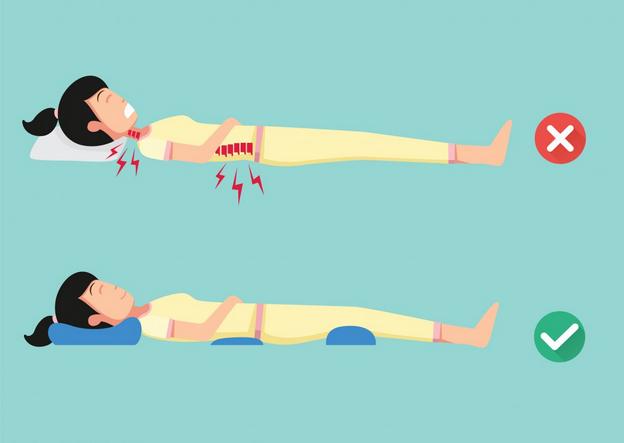
Stomach Sleeping
Sleeping on the stomach is not often recommended. This position commonly causes pain in the neck and low back. However, stomach sleeping can reduce snoring and help in some cases of sleep apnea.
Why should you avoid stomach sleeping?
Stomach Sleeping Cons
- Increased risk for neck pain due to having to turn to one side.
- Lying chest-down straightens your spine into an unnatural position and this leads to lower back pain.
- For pregnant women sleeping on one’s stomach is not only uncomfortable; it is not recommended.
How to Stomach Sleep Properly
If you insist you cannot sleep on your back or side try these ideas out:
- Switch out your pillow for a razor-thin one (or no pillow at all).
- Prop a pillow under your pelvis to add some curve to your spine.
- Do some stretches in the morning to ease back pain.
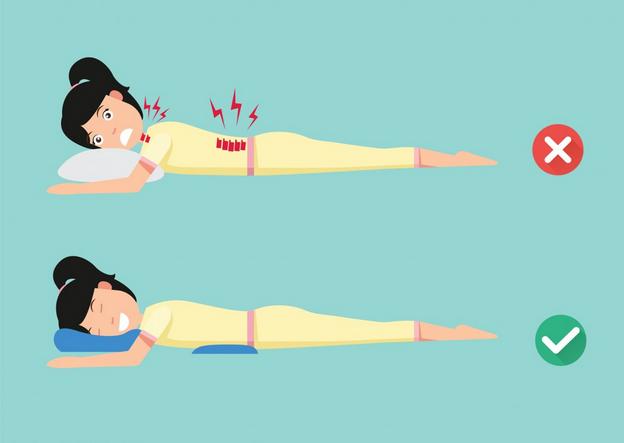
Transition to a New Sleep Position
Old dogs don’t like new tricks, right? Neither do we like to make a change in our sleep position - even when we agree that it could be the culprit of our morning aches!
The transition period to a new sleep position can be a difficult one. Maybe you will have trouble getting to sleep while trying the new position and that can seem to defeat the whole point!
But if the information we have provided has convinced you that a change is needed, stick it out. You really can develop a healthy new habit and your body will thank you for it.
Add these extra sleep tips to create a good sleep environment. They can help your transition go more smoothly:
- Block out all-natural light in your room. Add room darkening shades or curtains.
- Banish electronic devices from your bedside for the two hours leading up to your bedtime. Add a blue light filter to your device if you must have it nearby.
- Avoid anything stimulating during the few hours before bed. That includes work, exercise, caffeinated beverages, spicy foods, loud noises, and suspenseful entertainment.
- Go to bed at the same time each night and set your alarm for the same time each morning. This will help your body settle into a consistent rhythm and promote restful sleep.
- Try sleeping on the opposite side of your bed from what you usually do. Your body may be less likely to revert automatically to your old position.
- Invest in those items you determine that you need like a high-quality pillow, supportive mattress, and quality sheets.
You sleep for one-third of your life, ideally! Make these hours work for you and not against you. Make a commitment to stick with your new plan for 10 days and see if you don’t begin to feel better.
Come see us at Daniels Chiropractic to help ease your neck and back pain that remains. We want to help you feel, move, and live better.
Call us today for an appointment: 262-638-9999.
Daniels Chiropractic Office
2609 Rapids Drive
Racine, WI 53404
Phone: 262.638.9999
Fax: 262.638.0742
